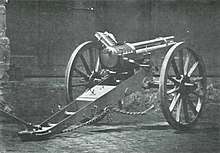Hotchkiss et Cie
Société Anonyme des Anciens Etablissements Hotchkiss et Compagnie was a French arms and, in the 20th century, automobile manufacturer first established by United States gunsmith Benjamin B. Hotchkiss. He moved to France and set up a factory, first at Viviez near Rodez in 1867, then at Saint-Denis near Paris in 1875 manufacturing arms used by the French in the Franco-Prussian war.

picture published 1874
Arms
An example of the company's output was the Hotchkiss revolving cannon (see picture from a privately circulated book dated 1874 by Alfred Koerner, later chairman of the company). The cannon had five barrels each able to fire 43 shells a minute a distance of one mile; it was made in four sizes from 37 mm to 57 mm, the largest intended for naval use. At the turn of the twentieth century, the company introduced the gas-actuated Hotchkiss machine gun, a sturdy and reliable weapon which was widely used during World War I and thereafter by the French Army.
Cars
At the start of the twentieth century the company started building cars. Information provided by the company for the International Universal Exhibition of 1900, at which it displayed a variety of cannons, said the St Denis factory employed around 400 staff and had 600 machine tools.[1]

The first Hotchkiss car, a 17 CV four-cylinder model, appeared in 1903. The badge for the marque consisted of a pair of crossed cannons—a salute to the company's first products.
A factory fire nearly killed all projects. Despite this, a six-cylinder model followed in 1906. During World War I, they mass-produced the Hotchkiss M1914 machine gun, tank parts and other weapons. In 1933, they developed the Hotchkiss H35 tank.
Post war came a luxury model called AK (6.6-litre) but only one was built. In 1920, there was an unsuccessful attempt to build Hotchkiss cars by a British arm of Hotchkiss in the United Kingdom—only a prototype was made.
A refined model named AM was in production between 1923 and 1928. A new six-cylinder model, named AM 80 came in 1928. The company made several successful racing cars. Hotchkiss racers won the Rallye Automobile Monte Carlo in 1932, 1933, 1934, 1939, 1949 and 1950.
The Hotchkiss 680 was an important model between the wars—it had a six-cylinder, 3-litre engine. In 1937, the company merged with Amilcar. J. A. Grégoire joined the company as a designer. After World War II, the 680 continued. The first new car post war was a 13 CV four-cylinder model. From 1947, two-litre flat-four models are frequently called Hotchkiss-Grégoire. In 1954, Hotchkiss purchased French manufacturer Delahaye, closing down their automotive line but continuing to produce Hotchkiss-Delahaye trucks for a few months before eliminating the Delahaye name completely. After 1954, Hotchkiss manufactured Jeeps under licence from Willys.
In 1956, Hotchkiss merged with French car manufacturer Brandt, producing jeeps at their factory near Paris for the French military until 1966. The firm was merged into Thomson-Houston in 1966 and in 1970 stopped producing vehicles. In the early 1970s, the Hotchkiss marque disappeared, as the French conglomerate came to be known as Thomson-Brandt. This, in turn, was nationalized in 1982 to form Thomson SA.
Hotchkiss Drive
The name of the Hotchkiss firm was given to a form of power transmission from a vehicle's engine by shaft to the differential on its back axle, which through leaf springs both locates the back axle and transmits drive forces to the vehicle, called Hotchkiss drive.
References
- "CNUM – 8XAE582.1 : p.130 – im.151". Retrieved 21 March 2016.